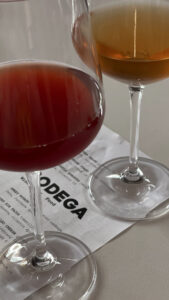Ever wondered what biodynamic wine is? Or natural? Or organic?
When I was growing up, wine came in two varieties: red and white. Occasionally, there was a secret third option: the rosé that was exclusively drunk by my grandmother, which I wholeheartedly believed was red and white mixed together (it is not). Even when I became legally able to purchase my own wine (an uncomfortable number of moons ago!), many of the wines and styles available today were not commonplace. Like the ever-expanding craft beer scene, the range of wine styles continues to evolve. Some of the descriptors and labels gaining popularity can be confusing, and unlike more strictly defined categories, terms like organic wine, biodynamic wine, and natural wine have fluid interpretations.
Understanding these terms can help you make more informed choices or embolden you to try something new. Here’s a breakdown of the key differences between some of these styles.

Organic Wine
Organic wine is organic like organic apples, or organic blueberries. Meaning it was produced using organic farming techniques. It requires certification from an agricultural authority in the country of origin, with requirements varying worldwide. Generally, organic wine certification involves:
- Conservation efforts, including climate and environmental protection
- Preservation of biodiversity and soil fertility
- Avoidance of chemical and synthetic products, as well as GMOs
- Transparent labelling for consumers
Despite these farming restrictions, organic winemakers can use many of the same techniques as conventional producers, so there is no guaranteed taste difference between organic wine and non-organic wine. However, organic wine often costs more due to lower yields and labour-intensive farming methods. Some people choose organic wine for its reduced sulfite content, as limited or no added sulfites are typically allowed.
Sustainable Wine Certifications
Some wineries obtain sustainable farming certifications, which are less stringent than organic certifications. These focus on reducing carbon footprints and preserving soil quality.
Organic or sustainable wine certifications do not typically affect the flavour of the wine, as the focus is on the farming practices not the wine making processes.
Biodynamic Wine
Biodynamic wine follows holistic farming principles, aligning agricultural activities with the Earth’s natural cycles. The approach was popularised by Rudolf Steiner in the 1920s, though similar indigenous farming practices date back millennia. Biodynamic farming treats the vineyard as a self-sustaining ecosystem, incorporating methods such as:
- Planting, pruning, and harvesting according to lunar and astrological cycles
- Maintaining biodiversity through integrated livestock and crop rotation
- Creating compost preparations using medicinal herbs
- Using cover crops and companion planting
Biodynamic wine does not have a uniform taste profile, as biodynamic certification does not dictate specific wine making methods. However, biodynamic wines are often described as more vibrant or “alive,” with pronounced freshness and bright flavours.
Natural Wine
Closely related to biodynamic wines, natural wines refer to wines grown with minimal commercial intervention, or the ‘natural way’. There may be significant overlap between organic or biodynamic farming and natural wine making, but natural wines typically refer to the winemaking process after picking rather than just the farming. A wine may be considered to be biodynamically or organically farmed, as well as made in the natural style.
Natural winemakers follow a “nothing added, nothing taken away” philosophy. They hand pick grapes, rely on native yeasts, and often even avoid temperature control during fermentation. Some natural winemakers don’t even prune their vines heavily, believing in minimal intervention at every stage.
The taste of natural wines can differ significantly from conventional wines. They often feel more vibrant and “alive” on the palate, with a lighter body and lower alcohol content. Natural wines are also more susceptible to variation between bottles and vintages and can sometimes have a slight fizz due to residual fermentation. They tend to be more acidic and tart and may develop “wild” flavours reminiscent of kombucha or yeast.
There is no certification for making a natural wine, (except in France) and different wineries may differ in how they make their ‘natural wine’. Enjoying natural wine is a personal preference, and you may like the flavour differences or you may not.
Vegan Wine
Vegan wine refers to wine made without animal-derived fining agents. Traditional winemaking often uses egg whites or gelatin for fining, whereas vegan winemaking substitutes plant-based alternatives.
Final Thoughts
None of these labels—organic wine, biodynamic wine, or natural wine—are indicators of quality. Instead, they describe differences in farming and winemaking techniques. You might prefer organic wine for environmental reasons, biodynamic wine for its holistic approach, or natural wine for its unique flavours. Ultimately, the best wine is the one you enjoy drinking.